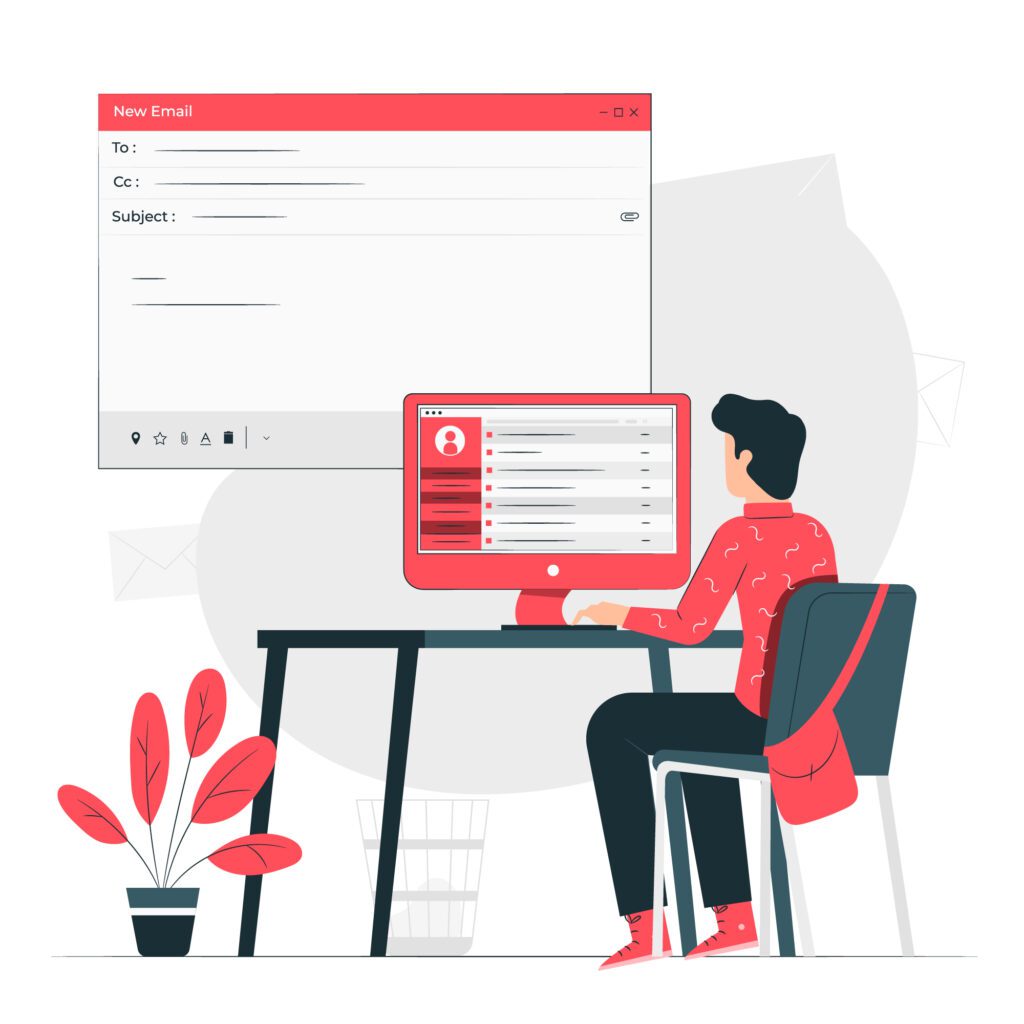Email Writing Format

SEO Meta-Description: Email Writing Format In this detailed blog, we will explore the essential aspects of email writing format. Learn the best practices, tips, and techniques to compose effective and engaging emails for various purposes.
Table of Contents
Introduction
Email is becoming a necessary component of both our personal and professional life in the digital age. Whether you are a student, a working professional, or a business owner, knowing how to write impactful emails is crucial for effective communication. Proper email writing format not only helps convey your message clearly but also reflects your professionalism and attention to detail.
In this comprehensive guide, we will delve into the key elements of email writing format and provide valuable insights based on first-hand experience and credible sources. So, let’s get started!
1. Understanding the Purpose of Your Email Writing Format
Every Email Writing Format you write should have a clear purpose. Whether it’s sending a job application, making a business inquiry, or reaching out to a colleague, identifying the purpose will help you structure the email effectively. LSI Keywords: effective email writing, purpose-driven emails.
When writing an email, ask yourself:
- What is the primary objective of this email?
- What response or action do I expect from the recipient?
2. Crafting a Compelling Subject Line
The subject line is the first thing your recipient sees, and it determines whether they will open your email or not. A well-crafted subject line is concise, engaging, and relevant to the content of the email. LSI Keywords: engaging subject lines, compelling email titles.
Remember these tips when composing your subject line:
- Keep it brief (around 6-8 words).
- Use action-oriented language.
- Avoid using all caps or excessive punctuation.
3. Salutations and Greetings
Choosing the right salutation sets the tone for your email. Addressing the recipient appropriately shows respect and professionalism. LSI Keywords: formal email greetings, appropriate salutations.
For formal Email Writing Format, use:
- “Dear [Recipient’s Name],”
For informal or familiar emails, you can use:
- “Hi [Recipient’s Name],”
4. Structuring the Email Body
The body of your Email Writing Format should be organized and easy to read. Use short paragraphs and bullet points to convey your message clearly. LSI Keywords: email organization, structured content.
Follow this structure for an effective email body:
- Introduction: Briefly introduce yourself and the purpose of the email.
- Main Message: Provide the necessary details or information.
- Call-to-Action (CTA): Clearly state what action you expect the recipient to take.
- Closing: Thank the recipient and include a closing remark.
5. Maintaining Professional Tone and Language
Regardless of the purpose, maintain a professional tone throughout the email. Use clear and concise language, avoiding jargon or technical terms that the recipient may not understand. LSI Keywords: professional email language, polite tone.
Remember these pointers:
- Be respectful and courteous.
- Avoid using slang or informal language.
- Proofread your email for errors before sending.
6. Personalization and Customization
Personalizing your email shows that you value the recipient as an individual. It can significantly improve engagement and response rates. LSI Keywords: customized emails, personalized communication.
Ways to personalize your emails:
- Use the recipient’s name in the greeting.
- Refer to previous interactions, if applicable.
- Tailor the content to suit the recipient’s interests or needs.
7. Adding a Professional Email Signature
An expert Email Writing Format signature functions as a virtual business card. It adds credibility to your communication and provides essential contact information. LSI Keywords: email sign-offs, contact details.
A well-designed signature should include:
- Your full name and job title.
- Company name and logo (if applicable).
- contact details, including a website and phone number.
8. Formatting and Proofreading
Formatting your Email Writing Format properly enhances readability and professionalism. Additionally, proofreading your email is essential to avoid embarrassing mistakes. LSI Keywords: error-free emails, email proofreading.
Keep these formatting tips in mind:
- Use standard fonts and font sizes.
- Break up long paragraphs for easier reading.
- Check for spelling and grammar errors before sending.
9. Email Etiquette and Best Practices
Following email etiquette ensures that your Email Writing Format are well-received and leave a positive impression on the recipient. LSI Keywords: email manners, proper email conduct.
Here are some best practices to adopt:
- Respond promptly to emails.
- Avoid using all caps (as it’s perceived as shouting).
- Be cautious with humor, as it may not always translate well in written form.
10. Handling Attachments and Hyperlinks
When attaching files or including links in your Email Writing Format, do so with caution to avoid overwhelming the recipient or triggering spam filters. LSI Keywords: email attachments, hyperlink usage.
Consider these tips when using attachments and hyperlinks:
- Compress large files before attaching them.
- Include a brief description of the attached files or links.
11. Dealing with Email Security and Privacy
Email security is crucial to protect sensitive information and prevent unauthorized access to your account. LSI Keywords: secure email practices, email privacy.
To ensure email security:
- For your email account, use secure and distinctive passwords.
- Be cautious when clicking on links or downloading attachments from unknown senders.
12. Email Follow-up and Response Management
Promptly responding to Email Writing Format and following up on important communications demonstrates professionalism and reliability. LSI Keywords: email response management, timely follow-up.
Consider these tips for effective follow-up:
- Create recurring reminders for critical emails that demand a response.
- Acknowledge receipt of important emails even if you can’t respond immediately.
13. Avoiding Common Email Mistakes
We all make mistakes, but some email blunders can be detrimental to your reputation. LSI Keywords: email errors, common email mistakes.
Avoid these common mistakes:
- Sending emails to the wrong recipients.
- Forgetting to attach important files.
- Using the “Reply All” function indiscriminately.
14. Writing Professional Emails for Job Applications
Job applications require special attention and a tailored approach. LSI Keywords: job application emails, email for job opportunities.
Tips for writing effective job application emails:
- Customize each application for the specific role.
- Highlight relevant skills and experiences.
15. Email Communication for Business Purposes
In the business world, effective Email Writing Format communication can lead to successful partnerships and collaborations. LSI Keywords: business email writing, email for business communication.
Tips for professional business emails:
- In the subject line, be sure to make your point.
- Keep the email concise and focused.
16. Sending Effective Sales and Marketing Emails
Sales and marketing Email Writing Format aim to capture the recipient’s interest and drive action. LSI Keywords: sales emails, marketing email strategies.
Key points for successful sales and marketing emails:
- Use persuasive language and compelling offers.
- Segment your email list for targeted campaigns.
17. Mastering Email Networking and Relationship Building
Networking via Email Writing Format can open doors to new opportunities and professional connections. LSI Keywords: email networking, relationship building emails.
Networking tips for emails:
- Genuineness and interest in the other person are key.
- Offer something of value before asking for favors.
18. Email Crisis Management and Conflict Resolution
In challenging situations, knowing how to manage conflicts and crises via email is vital. LSI Keywords: crisis communication emails, conflict resolution.
Guidelines for handling email crises:
- Stay calm and composed in your language.
- Offer solutions and seek resolutions.
19. Utilizing Email for Efficient Project Management
Email plays a crucial role in project management and team communication. LSI Keywords: email in project coordination, effective team communication.
Tips for using Email Writing Format in project management:
- Clearly define tasks and responsibilities in the email.
- Use email threads to track progress and discussions.
20. Effective Email Communication for Educational Purposes
For students and educators, Email Writing Format is an essential tool for academic communication. LSI Keywords: educational email writing, student-teacher communication.
Academic email etiquette:
- Address professors and peers respectfully.
- Use a formal tone in professional email exchanges.
21. Email Writing for Customer Service and Support
Customer service emails require empathy, clarity, and prompt responses. LSI Keywords: customer support emails, email for customer complaints.
Customer service tips for emails:
- Acknowledge the customer’s concern before providing a solution.
- Offer assistance beyond the initial query, if possible.
22. Leveraging Email for Event Invitations and RSVPs
Sending event invitations via email is a popular and efficient method. LSI Keywords: event invitation emails, email RSVPs.
Tips for crafting event invitations:
- Clearly state event details, date, and time.
- Request RSVPs for proper event planning.
23. Email Etiquette in the Age of Remote Work
With remote work becoming more prevalent, email etiquette is crucial in maintaining efficient communication. LSI Keywords: remote work emails, email in virtual workplaces.
Remote work email tips:
- Respect time zone differences when scheduling emails.
- Use video calls for complex discussions when needed.
24. Navigating Cultural Differences in International Emails
When communicating with individuals from different cultures, understanding cultural nuances is essential. LSI Keywords: cultural sensitivity in emails, international email communication.
Tips for international email communication:
- Research cultural norms and practices before sending emails.
- Avoid making assumptions about cultural preferences.
25. Email Automation and Time-Saving Tools
Email automation can streamline repetitive tasks and save valuable time. LSI Keywords: email automation tools, time-saving email solutions.
Popular email automation tools:
- Schedule emails in advance with tools like Boomerang or Sendinblue.
- Use email templates for common responses.
FAQs
Q: How long should my email be? A: Ideally, emails should be concise and to the point. Aim for 150-200 words for most professional emails.
Q: Is it essential to use email signatures for personal emails? A: While not mandatory, a professional email signature can add a touch of formality and provide contact details for easy reference.
Q: Can I use humor in professional emails? A: Using humor sparingly and cautiously can be appropriate in some cases, but ensure it aligns with the recipient’s personality and the context.
Q: How can I ensure my emails are not marked as spam? A: Avoid using excessive capitalization, too many links, or irrelevant content, as these factors can trigger spam filters.
Q: Should I respond to each email that I get? A: It’s courteous to acknowledge receipt of emails, but you can prioritize responses based on urgency and relevance.
Q: Can I use emojis in professional emails? A: Emojis can add a touch of friendliness, but use them sparingly and only when appropriate for the context.
Conclusion
Mastering the art of email writing format is a valuable skill that can significantly impact your personal and professional life. By following the tips and best practices outlined in this guide, you can compose impactful and engaging emails that leave a lasting impression on your recipients.
Remember to customize your approach for different scenarios, maintain a professional tone, and always proofread your emails before sending them. Effective email communication is a powerful tool that can open doors to new opportunities and build meaningful relationships.
So, next time you sit down to draft an email, apply the techniques discussed here, and watch your communication skills soar!
